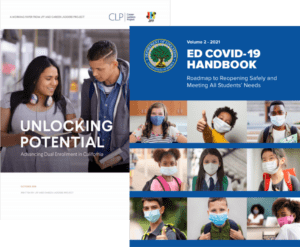 CLP’s research on dual enrollment, which highlights the critical importance of intentional design for equity and student completion, was cited in recently released guidelines from the U.S. Department of Education (ED). The COVID-19 Handbook, Volume 2: Roadmap to Reopening Safely and Meeting All Students’ Needs provides the evidence base for reopening America’s schools and in supporting students to succeed. And it suggests strategies worthy of investment with the forthcoming American Rescue Plan Act funds. The handbook identifies dual enrollment among the effective strategies to support transition from high school to college, especially given COVID-19’s adverse impact on the number of students matriculating from high school to postsecondary education.
CLP’s research on dual enrollment, which highlights the critical importance of intentional design for equity and student completion, was cited in recently released guidelines from the U.S. Department of Education (ED). The COVID-19 Handbook, Volume 2: Roadmap to Reopening Safely and Meeting All Students’ Needs provides the evidence base for reopening America’s schools and in supporting students to succeed. And it suggests strategies worthy of investment with the forthcoming American Rescue Plan Act funds. The handbook identifies dual enrollment among the effective strategies to support transition from high school to college, especially given COVID-19’s adverse impact on the number of students matriculating from high school to postsecondary education.
The guidelines emphasize the importance of designing dual enrollment for equity and completion, referencing CLP’s research. The ED handbook recommends that high schools:
“Support dual enrollment and early college high schools, which studies show increase postsecondary preparation and enrollment. These programs can serve as effective mechanisms at exposing high school students to college course-taking, providing a college reengagement strategy for students who are at risk of not continuing to postsecondary education upon high school graduation. Research suggests these dual or concurrent enrollment experiences must be well-designed with scaffolded supports to ensure equitable experiences and outcomes for all students.” (p. 23)
As schools reopen and colleges return to more face-to-face instruction and services, there is opportunity to expand and center dual enrollment on equity. Promoting high-quality dual enrollment for equitable completion is a major area of CLP’s current work. The paper cited in the ED report, “Unlocking Potential: Advancing Dual Enrollment in California,” was jointly developed with JFF and published in 2018. It provides an overview of lessons learned from research including CLP’s dual enrollment landscape and case studies. Since that time, CLP’s efforts have progressed to focus on high school/college partnerships in two dual enrollment communities of practice–one statewide and one in the San Francisco Bay Area region. We will share lessons learned and emerging practices from both projects. These practitioner-informed lessons and innovations will guide CLP’s work on the policy front to engage advocates and policy makers in crafting strategies, refining direction and building momentum for scale.
The ED handbook also identifies “college and career pathways that integrate rigorous academic coursework, career and technical education, work-based learning, and support services” as other effective strategies to support student transition to postsecondary education. Linked Learning was highlighted as an effective pathways approach that increases preparation for postsecondary education among other outcomes. CLP is a longstanding partner of the Linked Learning Alliance; previous collaborative work included leading the California Community Colleges Linked Learning Initiative, funded by the James Irvine Foundation. Other past projects on college and career pathways include capacity-building support for a number of California Career Pathways Trust regional consortia across the state.
Resources
- ED COVID-19 Handbook, Volume 2: Roadmap to Reopening Safely and Meeting All Students’ Needs
- Unlocking Potential: Advancing Dual Enrollment in California, a joint working paper from CLP and JFF
- CLP dual enrollment resources including the Dual Enrollment Landscape in California working paper and overview, case studies, videos, the Dual Enrollment Game, the DE toolkit, and more
- Recordings from CLP’s dual enrollment problem-solving webinar series, which engaged practitioners on strategies for supporting dual enrollment remotely during the pandemic
- Additional CLP publications on college and career pathways, work-based learning, dual enrollment, college redesign including guided pathways, and more